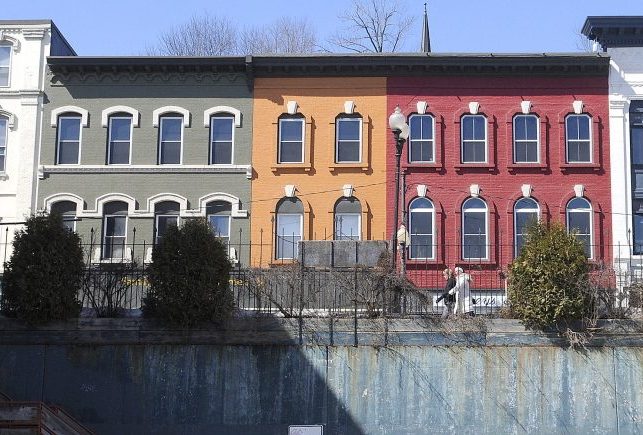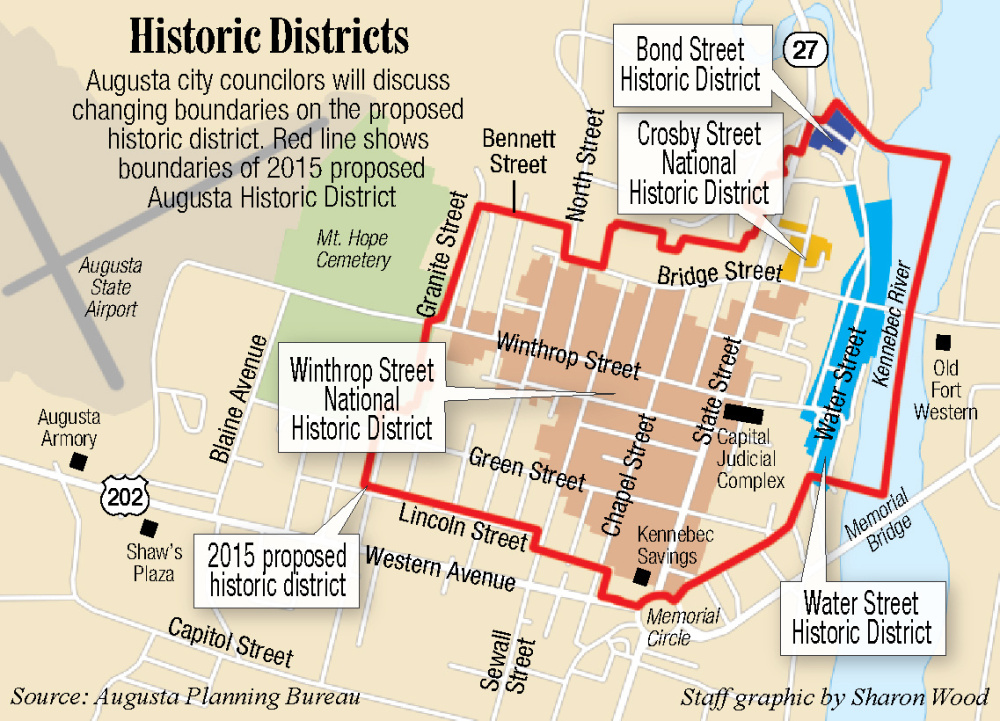AUGUSTA — A smaller area of the city would be subject to a newly revised historic district ordinance requiring property owners to have most building renovations that would be visible to the public undergo extra scrutiny by a review board.
New district boundary lines have been drawn by a historic preservation consultant, designating a smaller swath of the west side of Augusta as having to comply with the rules and review requirements of the Augusta Historic District Ordinance. The boundaries mirror the lines of districts already designated as national historic districts.
The largest of the districts, covering a major residential area surrounding Winthrop Street, is now substantially smaller than what officials first proposed under the ordinance. Changes leave out properties on several streets where there were some, but not as many, properties that met federal standards to be deemed “historic.”
“I prefer the smaller version; I think it makes more sense,” Mayor David Rollins said Tuesday. “People are often afraid of what they don’t know. Then once they see it, they’re OK. I think starting small and then, if future city councils or neighbors want to talk about expanding it, by all means.”
City councilors approved the Historic District Ordinance last May but due to concerns about what properties should be included within it, adopted the ordinance without designating what parts of the city would be subject to its rules.
City officials last year pulled back the previous, larger version covering a wider section of the same area after the district’s residents complained about having to follow the new rules, and questions were raised about whether the district contained too many properties deemed to be “noncontributing” to the district’s historic nature.
So the newly redrawn boundaries, within which the ordinance’s review requirements would apply, now contain a smaller area, with boundary lines contracted to exclude properties on multiple streets that previously would have been within the area subject to the new rules.
“It has contracted from what the original proposal was, which included a lot more of the west side neighborhood,” said Matt Nazar, city development director.
The newly redrawn boundaries include only properties already part of a national designated historic district, excluding properties that the city initially included in the proposed local historic district but which are not within the national historic district.
“Expanding (what had previously been designated part of a national historic district) without any experience in that caused a lot of angst for some people,” Rollins said. “A lot of people outside the national district, but inside the (previously proposed) local district, had a lot of questions about why their house was included in it.”
The new, shrunken district boundaries will go to the Planning Board for review and a public hearing next week; and if the proposal moves forward, it also would require approval by the City Council. That process also would include public hearings, according to Nazar.
Other, smaller historic districts that also fall within the rules of the local historic ordinance, on Bond Street and much of the downtown portion of Water Street, already have been approved and adopted. That leaves only the largest, most controversial district around Winthrop Street as the last remaining piece of the initial city proposal yet to be approved.
Augusta-based Sutherland Conservation and Consulting reviewed each of the buildings within the district to determine whether they should be deemed to be “contributing” historic buildings.
The proposal was first made in 2015, then delayed after facing criticism from property owners within the district.
Property owners said the ordinance’s requirements that most exterior work on buildings within the district, if it would be visible to the public passing by, be reviewed and approved by a new historic review board, could add time and cost to renovation projects.
Rollins said he prefers the new, smaller proposed district to the previous larger proposal, though he remains a strong advocate for a local historic district, which he said will help preserve the city’s historic buildings and character and make Augusta a more attractive place for both residents and visitors. He noted the city could adopt the current proposal and look to add new historic districts in the future.
The Planning Board is scheduled to consider the proposal at its meeting, which begins at 7 p.m. Tuesday in the council chamber at Augusta City Center.
Board members also are scheduled to continue postponed consideration of a mineral extraction license, including the ability to blast rock, for McGee Construction’s West River Road quarry, and a request from Cafua Management to add vehicle access from Sewall Street to Melville Street, where the company operates a Dunkin’ Donuts.
Keith Edwards — 621-5647
Send questions/comments to the editors.





Success. Please wait for the page to reload. If the page does not reload within 5 seconds, please refresh the page.
Enter your email and password to access comments.
Hi, to comment on stories you must . This profile is in addition to your subscription and website login.
Already have a commenting profile? .
Invalid username/password.
Please check your email to confirm and complete your registration.
Only subscribers are eligible to post comments. Please subscribe or login first for digital access. Here’s why.
Use the form below to reset your password. When you've submitted your account email, we will send an email with a reset code.